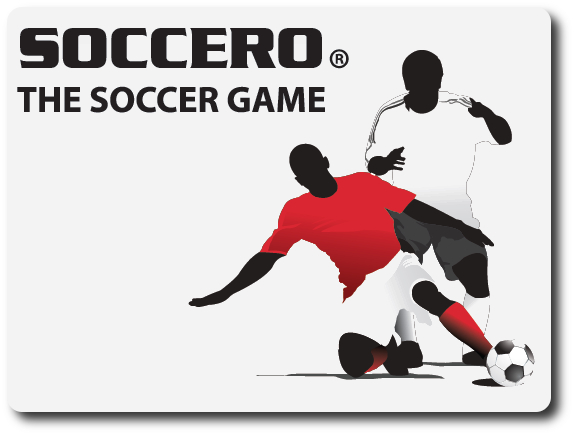
The Basics:
- For ages 8 and up (publisher suggests 11+)
- For 2 players
- Variable game length (determined by the players)
Geek Skills:
- Active Listening & Communication
- Counting & Math
- Logical & Critical Decision Making
- Strategy & Tactics
- Risk vs. Reward
- Visuospatial Skills
Learning Curve:
- Child – Easy
- Adult – Easy
Theme & Narrative:
- Lead your team as the Head Coach of a world-class soccer club!
Endorsements:
- Gamer Geek rejected!
- Parent Geek approved!
- Child Geek approved!
Overview
As your team runs out before the crowd, with the fans waving flags and cheering, you are filled with a wave of excitement! Your team has come a long way and proven itself to be true competitors. Now you are up against your greatest challenge and it’s time to see if all the practicing and drilling has paid off. As your players takes their positions on the field, you realize it’s too late to worry and focus on the game at hand.
Soccero (2nd edition), by Gamina Ltd, is comprised of 1 large foldout game board that represents the playing field, 1 Ball pawn, 2 Goals, 22 Player pawns (11 per player), 4 standard six-sided dice (2 red, 2 white), 2 Kick dice (custom six-sided die), and 2 sand timers (1 red, 1 white, 30 seconds each). All the pieces are made of plastic (except the game board) and each of the Player pawns are well sculpted and painted with detail to make each look like a real soccer player (each team has their own jersey color). As an extra bonus, the Ball pawn is sculpted to look like a real soccer ball, and the goals are raised and above the game board. Simply outstanding attention to detail. Not included in the game, but necessary to play, is a pen or pencil and a piece of paper to keep track of the score and a stopwatch or some other timekeeping device.
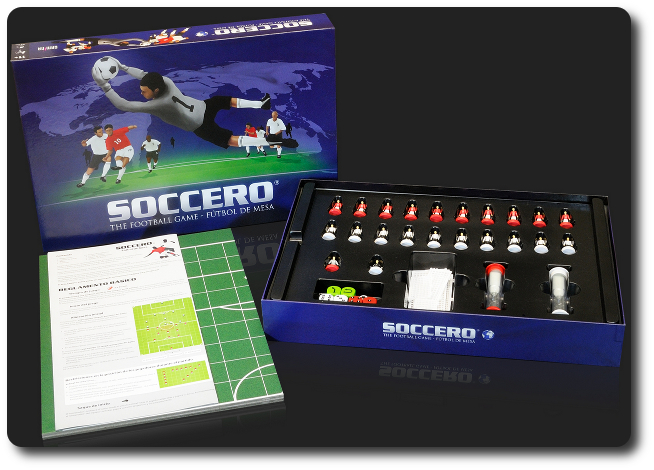
Game Set Up
To set up the game, first unfold and place the game board in the middle of the playing area. We suggest each player sit opposite of each other with a goal to their left and right.
Second, take and place the Goal pieces on the board. The Goal pieces have small pegs on each of the four posts. On the game board, located in the goal position, are four small holes. Line up the Goal post pegs with the holes on the board and make sure the Goal’s entrance is facing towards the center of the field.
Third, have each player select a team color (red or white) and collect all 10 Player pawns of that color. Each player should also select one of the two goalkeepers, take the two six-sided die that match their team’s jersey color, one of the two sand timers, and one of the two Kick dice.
Fourth, flip a coin to determine who will have possession of the ball first.
Fifth, using the detailed illustration in the rule book, each player will now place their Player pawns in the field at their starting positions along with the Ball pawn.
Sixth, determine how long each half of the game will be. The recommended time limit for each half is either 45 minutes or 20 minutes. Note that this is “real-time”. For example, two 45 minute halves will take 90 minutes to play a full game. The clock doesn’t stop for players to make up their mind, roll dice, or move their pawns.
That’s it for game set up! Start the clock and kick off!
The Basic Game
Note: Soccero has two different game versions. The Basic game (the one we will discuss here) comes with the game box. The Extended game (note discussed in detail here) covers the more technical and detailed rules of a real soccer game, expanding off the Basic game rules. As a result, the Extended game is much more accurate and challenging. Both the Basic and the Extended game rules are freely available to download and review on the game’s official web site. Regardless of which game version you eventually enjoy playing, we highly recommend you always start with the Basic game when first learning Soccero.
The game always starts with a kick off. This is done with the player who currently has possession of the ball moving the Ball pawn from the Player pawn in the center to a Player pawn adjacent to it. This is the only time this type of simple Ball pawn movement and placement will occur. After the kick off, the player takes another turn. Once a player has completed their turn, the next player goes and so on. This continues until the time has run out for the half. The sand timers can be used to give each player 30 seconds to determine what they want to do on their turn. If the player fails to complete their turn within the 30 seconds, all Player pawns and the Ball pawn will be placed back in their original position prior to the player taking their turn. Their opponent will now go. The sand timers are optional and only serve to keep the game’s pace and each player’s turn at a reasonable length of time.
After the initial kick off, each player on their turn must decide what they want their team to do. There are only two options, move players or kick the ball, but with each option are multiple steps. They are summarized here and only one can be taken per turn.
Move Players
This option allows the player to move their Player pawns around the game board into better positions. A single standard six-sided die is rolled. The value that is rolled represents the total movement points the player has to spend on this turn. A player is welcome to move as many Player pawns as they like, but each square a Player pawn moves counts as 1 movement point. Additionally, each Player pawn can only move once per turn, can only travel in a straight line (horizontally, vertically, or diagonally), and cannot move through another Player pawn (unless attempting to steal the Ball pawn from their opponent).
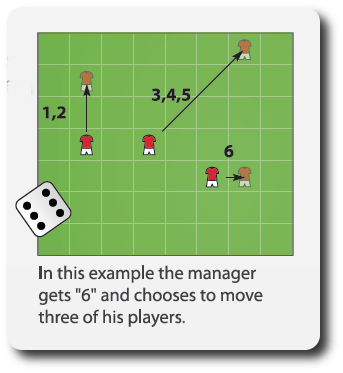
If the player attempts to steal the ball, the player must be able to move one Player pawn the exact number rolled on the die to end their turn in the same square as the opponent’s Player pawn who currently has the Ball pawn. For example, if the die value rolled is a “3”, and the opponent’s Player pawn is exactly 3 squares away with the Ball pawn, the player can move their Player pawn to that space and take possession of the ball. The opponent’s Player pawn is relocated to one of the 8 squares around the Ball pawn.
A Player pawn who currently has the Ball pawn moves as normal. The Ball pawn will travel with the Player pawn until it is kicked, stolen, or left. The player can leave the Ball pawn in a square and have the Player pawn who just controlled it move on. This frees up the ball for another Player pawn to either pass through or stop on the square with the Ball pawn and pick it up.
Note that the Basic game does enforce restrictions on Player pawn positions during the game. For example, if a Player pawn is ever nearer to their opponent’s end line than both the Ball pawn and the second-to-last opponent’s Player pawn (including the goalkeeper), offsides can be called resulting in the Ball pawn changing player possession. Offsides looks like the following image. It’s up to the other player to recognize and call it, however.
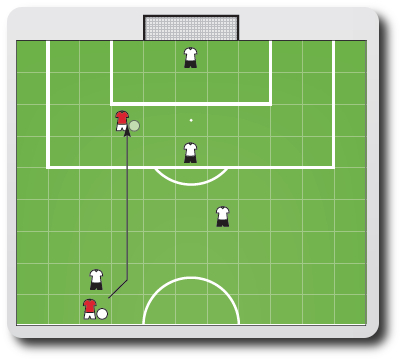
Kick the Ball
Obviously, this option is only available to the player if one of their Player pawns currently has possession of the Ball pawn. Like Player pawn movement, a standard six-sided die is used, but so is the Kick die. The game comes with 2 Kick dice (one per player) and each die is identical. On each of the die faces is one of 3 possible kicks, but the odds of some kicks being available are higher than others. While the Kick die will determine the type of kick, the standard six-sided die will determine the distance the Ball pawn will travel. The player has the option of rolling one or both of their standard six-sided dice. All dice are rolled at the same time to determine the kick action, with the standard six-sided die or dice showing the power behind the kick (movement points) and the Kick die determining the kick type. The possible kick types are summarized here.
- Direct Kick on the Field (2 possible out of the 6 sides): The Ball pawn is moved in a straight line like a Player pawn during Player movement and stops as soon as it encounters another Player pawn, it goes out-of-bounds, or it moves its maximum number of movement points.
- Curve Kick on the Field (3 possible out of the 6 sides): The Ball pawn moves in a straight line like a Player pawn during Player movement, but the player has the option of adjusting its path by 45 degrees once during its movement. Like the Direct Kick, the Ball pawn stops as soon as it encounters another Player pawn, it goes out-of-bounds, or it moves its maximum number of movement points.
- Curve Kick in the Air (1 possible out of the 6 sides): The Ball pawn moves exactly like a Curve Kick on the Field, but the Ball pawn is not stopped automatically by Player pawns in its path. The Ball pawn can be stopped, however, by the player who currently has possession of the ball by any of their Player pawns in the Ball pawn’s path.
When the Ball pawn goes out-of-bounds, it remains in the square. The nearest Player pawn of the opposite team is then relocated to that square and it is now that player’s turn, with the Ball pawn possession switching sides.
GOOOOOOOOAAAAAAALLLLLLLL!
Eventually, a player will be in range to attempt to score a goal. All shots on the goal must be declared prior to the player attempting to score a point, with all normal kicking rules applying. To score, the Ball pawn (once kicked) must be able to travel the entire distance between the Player pawn that kicked the ball and end its movement past the goal line (the back of the Goal ends all movement). If the player is particularly skilled, they can cause the Ball pawn to rebound off a Goal post, changing it’s movement path 45 degrees in the process!
If the Ball pawn crosses into the square where the goalkeeper is and the ball is on the ground, it is automatically stopped. Of course, the goalkeeper has an opportunity to dive for the ball before it goes in, too, but this is only possible if the ball travels in a square directly left or right of the goalkeeper inside the penalty area and the ball is on the field. If the conditions are met, the player controlling the goalkeeper rolls a single standard six-sided die. On a value of 1 through 4, the goalkeeper lets the ball slip through their gloved fingers. On a value of 5 through 6, the goalkeeper makes a spectacular save and moves to the square where the ball almost passed them. The goalkeeper is now in possession of the Ball pawn.
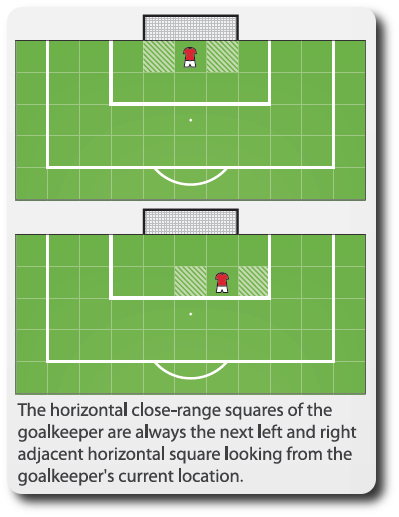
If a goal is scored, the point is recorded, and the field is reset with each Player pawn being moved to their initial position prior to the game’s first kick off. The player who just had a point scored against them will kick off the ball.
Halftime and Game End
When the predetermined time for the first half ends, the game immediately stops, regardless of who has the ball and what the current action is. The field is reset with each Player pawn being moved to their initial position prior to the game’s first kick off, but on the other side of the field. For example, if the player was working to score points against the goal on their right during the first half, they will now be attempting to score points on the goal to their left during the second half. The player who did not start the game with the kick off during the first half will kick off the ball for the second half.
When the predetermined time for the second half ends, the game immediately stops and ends. The player with the most points wins the game. In case of a tie, the game is a draw.
A Quick Word on the Extended Game
The Basic game does a great job of introducing the core game mechanisms used during game play. It fails, however, to truly capture all the exciting moves seen in most real soccer games. The Extended game rules cover weak shots, headers, fouls, sanctions, special situations, punt kicks, goal kicks, corner kicks, thrown-ins, free kicks, and penalty kicks. It also includes a few optional rules for automatic stealing, an easier way to handle the rules for carrying the ball, extra kicks from a pass, and an extra kick after a Player pawn gains possession of the Ball pawn.
To learn more about Soccero and read the full rules, see the game’s official web site.
Prediction
Soccer, or “Football” as it is known just about everywhere else in the world except the United States, is one of those sports that is sadly not as big as it should be here in America. I played soccer a great deal during my younger years and well into college. I loved it and have had the opportunity to coach youth soccer a number of times. Now it’s my turn to sit on the sidelines and cheer on my little geeks as they run from one end of the field to the other…and not always with the ball. Soccero would appear to be the perfect sports board game to allow me to relive many of my happy soccer memories without ever getting winded.
The Basic game is very basic, indeed. In fact, it’s just one step above “roll-and-move”. This is going to leave a bad taste in the Gamer Geeks’ collective mouths, but I should also state that the Gamer Geek group I will be playing the game with are not well versed in sports board games. I predict a bit of whining from the Gamer Geeks in regards to dice determining total movement of their team and how the ball will fly. For the Parent Geeks and the Child Geeks, I think they are going to enjoy this game very much. The Basic game rules read like they can be easily taught to a player as young as 8-years-old, if not younger.
Teaching the game doesn’t take much effort, but it will require you to do a number of demonstrations. On average, I spent about 15 minutes teaching the game to the Child and Parent Geeks. I think it only took about 10 minutes for the Gamer Geeks who, after hearing enough about the game to be dangerous, decided to learn the game’s subtle nuances while they played. Teaching my little geeks was an interesting exercise in keeping them on task. Both my 5 and 8-year-old are familiar with the rules of soccer and kept asking me how they would do certain moves in the game. For example, my oldest kept asking me about the famous bicycle kick. The Extended game rules do not cover this. Once I taught them the basics, however, they felt confident enough to play. And so, as I set the game board up for our game’s starting kick off, I asked them both for their initial thoughts on Soccero.
“This is so cool, Dad. I’ve seen football and baseball games, but never a soccer game!” ~ Liam (age 8)
“I really like the little guys and how I get to control them on the field!” ~ Nyhus (age 5)
Both of my little geeks are ready to play. Let’s kick the ball around a bit and see if the game is worth the effort.
Final Word
The Child Geeks really liked the Basic game, but never moved to the Extended game. In fact, they never wanted to. The Basic game provided them with the right level of difficulty and game engagement to keep them interested and entertained throughout. We never played a 40 minute or longer game, either. We kept our halves down to 10 minutes each and played as many games as patience permitted. Child Geeks as young as 5-years-old could play this game, but with assistance. Because of how many times we needed to help them, we were unconvinced they could play it well enough to be competitive on their own. As such, we can only recommend this game is playable with Child Geek as young as 8-years-old. Regardless of age, however, all the Child Geeks who played it where happy to approve the game for their endorsement.
Parent Geeks also had a wonderful time with the game. They didn’t care for Soccero when they played it against their peers (Parent Geek versus Parent Geek) and always preferred to play the game with their Child Geeks. The game is very well-balanced and makes the playing field, both literally and figuratively, even between the players regardless of age or skill. Technically, the players who could think several turns ahead would have an advantage, but the real winners where the players who could easily adjust to the changes on the game board. The Parent Geeks hailed Soccero as a wonderful 2-player sports game with outstanding quality production value and a high level of replay.
Gamer Geeks were not impressed at all with the Basic game. In fact, all Gamer Geeks who played the Basic game thought Soccero was a total bomb. “This is a roll-and-move game with a soccer ball”, they would say. And you know what? They are correct, but there is no way to avoid it. The game breaks down to rolling die and then using the points to move the players or the ball. This was found to be too simple and too restrictive by the Gamer Geeks, despite the fact that all movement and decisions are tactical and strategic. It wasn’t until I introduced the Extended rules that the Gamer Geeks started to speak more positively about the game, but even then, only those Gamer Geeks who also enjoyed soccer approved of Soccero. In the end, not enough Gamer Geeks approved the game to grant it the Gamer Geek approved endorsement. Those Gamer Geeks who enjoyed soccer and sports games did enjoy Soccero, however, and recommend you play it.
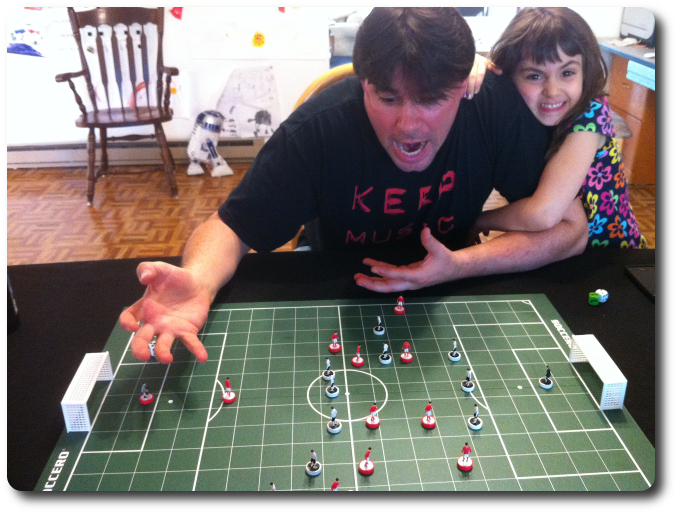
A Gamer Geek rages against the game…seconds away from flipping the table. He lost the game.
The Basic game is too basic for my taste, but it’s highly worthwhile. It does a great job of teaching the game and getting you interested in playing more. It’s also a great way to determine if you are even interested in the game to begin with. Players who didn’t care for the Basic game seldom enjoyed the Extended game with the advanced rules. For those players who left the table feeling good about the game but wanted more out of it, the Extended rules did a lot to satisfy them. I highly recommend you start with the Basic game and play that until everyone is comfortable with the basic rules. This shouldn’t take any more than 2 games at most. Once the Basic game is well understood, your next goal (if you’ll excuse the pun) is to get as many of the Extended game rules in play as soon as possible. The game feels more tactical, more energetic, and lot more fun as a result.
Overall, I am highly pleased with Soccero. The Basic game didn’t do it for me and several of my initial plays left me feeling greatly disappointed. In fact, I’m on record on Twitter stating the game never felt like a real soccer game to me. I stand by that statement but only in the context of the Basic game. The Extended game completely changed my point-of-view and I began to appreciate it on an entirely new level. Indeed, it’s like a different game. The Extended game introduces fun rules for game play resulting in more depth, more thought, and a lot of tense moments! Simply wonderful and a real winner. I greatly enjoy playing Soccero and would recommend it to anyone who is a soccer fan. The only thing it is missing is real player stats, but this seems totally unnecessary. Especially when you are fully engrossed in a devilishly tricky play up the middle with only a minute left on the clock and one point behind!
If you are looking for a soccer board game where strategic thought and a little luck go hand-in-hand, where moving players is a strategic exercise in the same vein as moving troops across a battle field, and plays can be terribly intense and exciting, with fast passes and quick kicks, do take a look at Soccero.
This game was given to Father Geek as a review copy. Father Geek was not paid, bribed, wined, dined, or threatened in vain hopes of influencing this review. Such is the statuesque and legendary integrity of Father Geek.




Been looking to buy this for a while. What are the best options to get a copy in the UK.? I have a friend even willing to send/bring from Spain where most of the distributors where based. Seen 2 copy’s in eBay US but that’s going to be £150 which seems excessive. Thanks- John
Thanks for reading the review and taking the time to leave a comment, John.
Have you tried Board Game Geek? It is a BIG website dedicated to the board game hobby. It has a feature that allows members (membership is free, by the way) to offer trades for games. In this case, there are other gamers looking to trade their copy of Soccero for another game. I bet you can get a pretty good deal and pass on a game you might not want to play anymore.
Give it a shot!
https://boardgamegeek.com/boardgame/131581/soccero-second-edition/trading?status=fortrade
HAPPY GAMING!